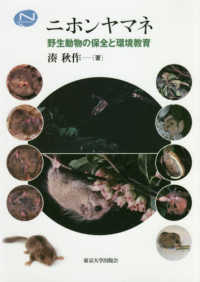- ホーム
- > 洋書
- > ドイツ書
- > Humanities, Arts & Music
- > Religion & Theology
- > practical theology
Description
(Text)
This book traces how religion could have originated in prehistory and antiquity, out of natural human and prehuman behaviour.
Religion is defined here as beliefs, conceptions, practices and roles concerned with the 'supernatural'. A variety of elements of religion can be identified. These include: spirits, ghosts, life after death, heaven, shamans. To try to reduce religion to a single original element is a mistake. There may be no single origin. But the individual elements have separate origins, and these can be traced.
The common subjective component of religious elements is the numinous, which is commonly ascribed to external sources identified as 'supernatural' and 'spiritual'. The numinous sense is explained by means of certain neural processes with a focus in the temporal lobes.
Probably for the first time, evidence is brought to bear from primatology, palaeoanthropology, ethnography, ancient history and history of religions, as well as theology, neurology andpsycho-pharmacology.
The field of origins of religion has been neglected by anthropology since the 1930s, but has enjoyed renewed interest from the 1990s. This wide-ranging interdisciplinary book makes an important contribution to the field.
(Table of content)
Contents: Principles and Parameters - The Numinous: Subjective Supernatural Experience - The Neural: Brain Structures and Processes - The Numinous Neural: Hypotheses - The Simian Substrate: Apes and Prehumans - Animatism: Numina, Daemons - Animism: Ghosts, Souls - Another World: Life after Death - Another World: Heaven - Religious Specialists: Shamans.
(Author portrait)
The Author: Richard Clark has had two careers: in the computer industry and for the last ten years in education. He holds degrees in Philosophy, Computer Science and Religious Studies. Dr Clark is currently headmaster of a school in Kenya.







